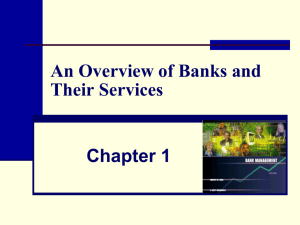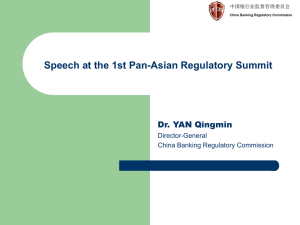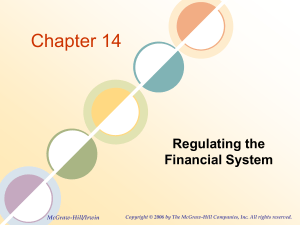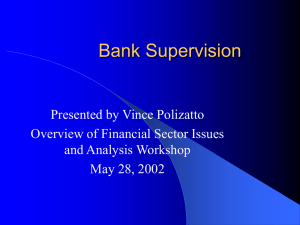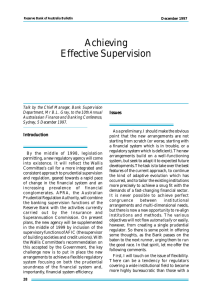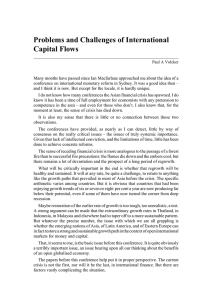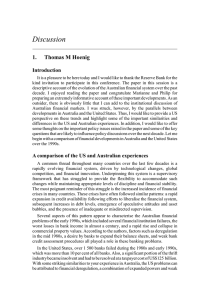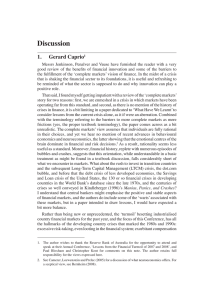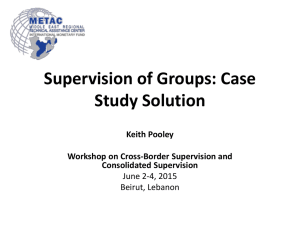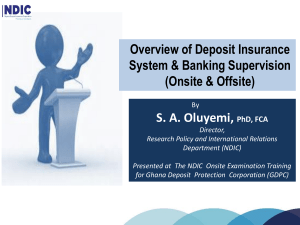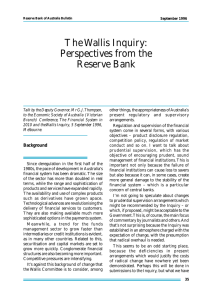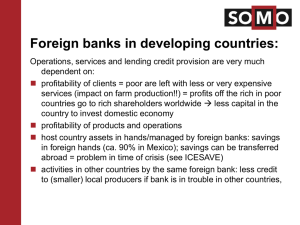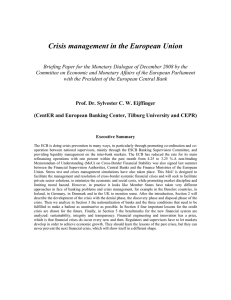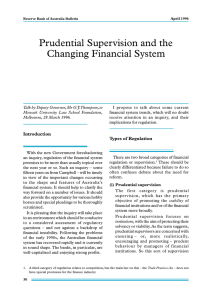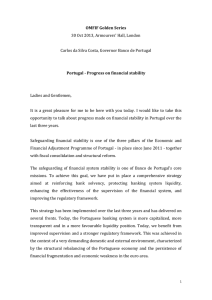A. Banking Supervision - London School of Economics and Political
advertisement
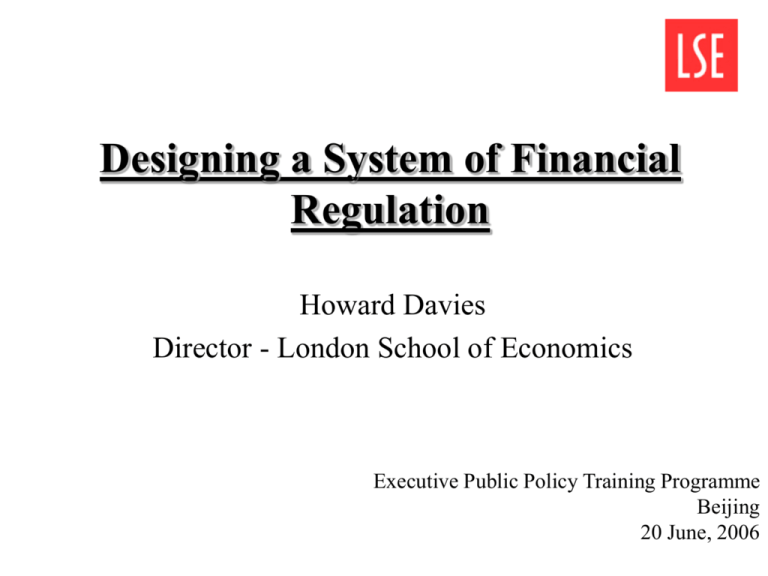
Designing a System of Financial Regulation Howard Davies Director - London School of Economics Executive Public Policy Training Programme Beijing 20 June, 2006 Five Steps to Reform 1. Assess the strengths and weaknesses of the financial system 2. Determine the desired future shape of the system how flexible? how open? 3. Assess compliance with international standards 4. Review the structural options 5. Map them against local market conditions 1. The Strengths and Weaknesses of the Financial System Global Financial Stock 2004 (%) China is becoming a significant part of the global system 16.5 23 4.5 Eurozone UK Japan China Rest of World 6 15 Source: McKinsey Global Institute, 2006 Financial Depth – Financial Stock as % of GDP 2004 China’s financial system is already well-developed 450 400 350 (%) 300 250 200 150 100 50 0 Japan US UK Eurozone China India Source: McKinsey Global Institute, 2006 Bank Deposits as % of Financial Stock But it is very heavily dependent on banks 70 Percent (%) 60 50 40 30 20 10 0 US Eurozone India China Source: McKinsey Global Institute, 2006 Chinese Share of Global Financial Stock (%) 2004 And the capital markets are relatively small Percent (%) 10 8 6 4 2 0 Private Debt Government Debt Equities Bank Deposits Source: McKinsey Global Institute, 2006 2. The Desired Future Shape of the System • Meet WTO commitments • Strengthen competitive pressures: greater flexibility • Expand capital markets as a source of finance for growth » equities » private sector bonds • Improve financial services for lower income families, and in remote areas 3. Compliance with International Standards The International Financial Architecture G7 Finance Ministers International Monetary Fund Financial Sector Assessment Programmes World Bank ICFC Global Financial Stability Report Financial Stability Forum ADB IADB EBRD etc A. Banking Supervision Bank of International Settlements Basel Capital Accord G10 Governors + Heads of Supervision Basel Committee G10 + Spain, Luxembourg EC ECB Central Banks and Supervisors B. Securities Regulation IOSCO- Core Principles Multilateral MOU C. Insurance Regulation IAIS - Solvency Standards D. International Accounting Standards 4. Review the Structural Options Four main models in operation elsewhere • ‘3 pillars’: banking, securities and insurance separately regulated • ‘Twin Peaks’: separation of prudential and conduct of business regulation • ‘Hybrid’: where two or more sectors are regulated together • ‘Integrated’: a single regulator covering most or all of the financial sector. There is no clear consensus about which model is ‘best’. Structure of Supervision in 77 Countries, 2002 Agency supervising two types of financial intermediaries Indicator Countries Single supervisor for Banks and Banks and Securities firms Multiple the financial system securities firms insurers and insurers supervisors Austria, Bahrain, Dominican Austria, Belgium, Bolivia, Chile Argentina, Bahamas, Bermuda, Cayman Republic, Finland, Canada, Colombia Egypt, Mauritius, Barbados, Botswana, Islands, Denmark, Luxembourg, Ecuador, El Slovakia, South Brazil, Bulgaria, China, Estonia, Germany, Mexico, Salvador, Gibraltar, Hungary, Switzerland, Guatemala, Greece, Hong Kong Iceland, Ireland, Uruguay Kazakhstan, (China), India, Japan, Latvia, Malaysia, Peru Indonesia, Israel, Italy, Maldives, Malta, Venezuela Jordan, Lithuania, Africa, Ukraine Cyprus, Egypt, France, Nicaragua, Norway, Netherlands, New Singapore, Rep. of Zealand, Panama, Korea, Sweden, Philippines, Poland, United Arab Emirates Portugal, Russia, United Kingdom Slovenia, Sri Lanka, Spain, Thailand, Turkey, United States % of counties 29 8 13 9 38 in the sample Source: Luna Martinez and Rose (2003) There is a trend towards integrated regulation for a number of reasons - growth of financial supermarkets - risk transfer between sectors - attractions of ‘one-stop shopping’ Main Reasons for Adopting Integrated Supervision (agencies indicating any one of the following reasons Reasons Number of Agencies Percentage of all agencies Improve the supervision of a financial system moving towards universal banking 14 93 Maximise economies of scale and scope 12 80 Solve problems resulting from poor communication and lack of cooperation among existing supervisory agencies 4 27 Minimise gaps in the regulation and supervision of financial intermediaries 3 20 Facilitate operational restructuring of regulatory agencies (in particular, after a financial crisis) 3 20 Overcome other weaknesses in the overall quality of financial regulation and supervision 2 13 But there are also important variations between integrated regulators - scale - scope - powers Powers of the Integrated Supervisory Agencies over Banks Regulatory and supervisory agencies Number of agencies % of all agencies Conduct on-site examinations 15 100 Conduct off-site examinations and surveillance 15 100 Impose sanctions and fines for non-compliance with rules and regulations 15 100 Set prudential regulation on market, credit, operational, and liquidity risks 12 80 Set accounting rules and information disclosure requirements 11 73 Set rules on the composition of capital 11 73 Approve and revoke a license to a financial intermediary 11 73 Set minimum capital requirements 10 66 Set licensing requirements 9 60 Consumer protection (assist to resolve claims for abuses against users of financial services) 9 60 Source: Luna Martinez and Rose (2003) How the Centres Rank in Terms of their Regulatory Environment Market participants tend to favour integrated regulation Average Score 20 18 16 14 12 10 8 6 4 2 0 London New York Paris Frankfurt Source: Z/Yen, 2005 5. Map options against local market conditions China now operates a ‘3 pillar’ model, but with banking supervision outside the central bank • suitable where there is little ‘cross-sectoral’ activity • also where a single agency might be seen to be ‘too powerful’ • and where sheer scale makes effective management difficult. Regulatory Reform in China is under way - 3 commissions: CBRC, CSRC, CIRC - International Advisory Councils - Training - Culture of challenge - Overarching body to resolve inconsistencies and promote co-operation An integrated regulator might be more appropriate if • banks are allowed to undertake other activities: universal banking • derivatives markets develop, allowing risks to be transferred between sectors • multi-functional overseas firms enter the markets on a large scale Designing a System of Financial Regulation Howard Davies Director - London School of Economics Executive Public Policy Training Programme Beijing 20 June, 2005






